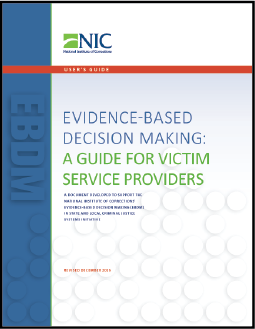
The purpose of this Guide is to prepare and assist VSPs [victim service providers) to become part of an EBDM [Evidence-Based Decision Making] policy team, as outlined in "A Framework for Evidence-Based Decision Making in Local Criminal Justice Systems". To help prepare VSPs for this role, the Guide provides: A rationale for VSPs to become involved with the policy team; An examination of the benefits that can accrue from the participation of VSPs in the EBDM process; A description of how VSPs can become part of the EBDM process and how the EBDM principles apply to their work; An exploration of common interests and potential challenges and barriers that VSPs and criminal justice system stakeholders collectively face while engaging in this work, and possible solutions; A link to a primer on EBP and EBDM; A brief overview of why it is important to victims for VSPs to understand the purpose and use of risk/needs assessment tools, a critical component of EBP and EBDM; and Links and references to other information and resources that can help VSPs to educate themselves about becoming part of EBDM policy teams and to conduct evaluations of their own programs" (p. 4). Sections include: introduction; Ten Core Crime Victims' Rights; advancement in the criminal justice system—evidence-based practice (EBP) and evidence-based decision making (EBDM); purpose of this guide; audience for VSP User's Guide; why VSP's should participate in the EBDM process; the unique contribution VSP's can make to the EBDM policy team; becoming part of the EBDM process; what EBDM means to VSPs; how the EBDM principles apply to VSPs; VSPs as an integral part of an EBDM process—what an ideal scenario would look like; VSPs' involvement in key decision points in the criminal justice system—decision points in the EBDM process, and intersection of EBDM decision points and victim considerations; common interests and potential challenges and solutions—prevention, offender accountability, victim needs, limited resources, working with diverse populations, and navigating a complex political environment; conclusion; and a holistic approach to serving victim needs.
